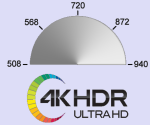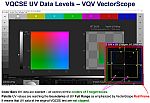 |
|
VQCSE
VideoQ Color Space Explorer
Dynamic Test Patterns Suite
Picture quality control, calibration and verification tool
for the 8K / 4K / 2K, HDR / SDR environment
VideoQ VQCSE Training Presentation
-
Easy-to-use tool, instantly revealing your video device / system / workflow performance.
- 1 frame size: 4K UHD, up- and down-converted versions available on request
- 2 color spaces: YUV and RGB
- 3 dynamic range modes: HDR-PQ, HDR-HLG, SDR
- 8 frame rates: 23.976, 24, 25, 29.97, 30, 50, 59.94 and 60 fps
- Insert test pattern at the source or any other test point within the workflow, e.g. encoder input
- Check colors representation at the output of the encoder, transcoder or packager
- Finally, check it again at the player/display screen output
VQCSE tests can be used for visual estimation and/or instrumental analysis.
Applications:
Video workflows, displays, transcoders, and video players development and certification.
QCSE tests are useful when streaming in multiple formats or when converting between formats.
The layout, data levels and appearance of the SDR variants of VQCSE test pattern suite are similar to the HDR-PQ and HDR-HLG variants, which makes much easier the usage of the whole VQCSE suite in modern mixed formats environments.
VQCSE suite includes 48 combinations of:
Each MP4 media file is produced by a lossless 444 10b HEVC encoder.
The major effort in capturing, delivering, and rendering of high-quality moving images, demands the guidance and commonly accepted rules.
The issues of tone mapping, color legalization, color banding and bit depth handling, are not yet fully resolved and often misunderstood.
The solution, is to establish easy-to-use rules and related tools, through the expanded derivatives of VideoQ Color Space Explorer Test Patterns suite.
The so-called 'three-point monitoring' approach provides for the correct detection of workflow parts responsible for the overall color distortions:
Note that Y banding distorsions are hardly noticeable on Gray Ramps, i.e. 10 bit depth is preserved.










